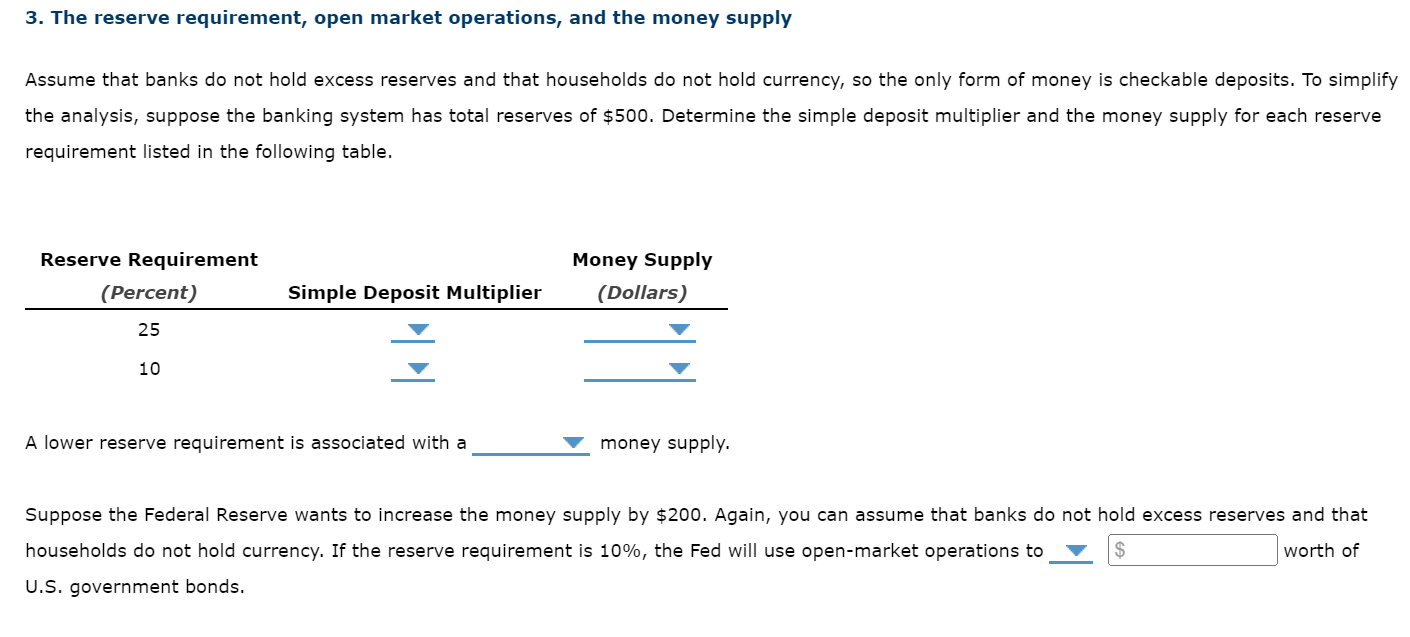

A lower reserve requirement is associated with a
smaller/larger money supply.
Suppose the Federal Reserve wants to increase the money supply
by $200. Again, you can assume that banks do not hold excess
reserves and that households do not hold currency. If the reserve
requirement is 10%, the Fed will use open-market operations to
buy/sell $_______worth of U.S. government
bonds.
Now, suppose that, rather than immediately lending out all
excess reserves, banks begin holding some excess reserves due to
uncertain economic conditions. Specifically, banks increase the
percentage of deposits held as reserves from 10% to 25%. This
increase in the reserve ratio causes the multiplier
to to fall/rise 1/ 2.5/4 or
10 . Under these conditions, the Fed would need to
buy/sell $______worth of U.S. government bonds in
order to increase the money supply by $200.
The simple deposit multiplier answers are 1/ 2.5/ 4/10/25
Money supply answers are 500/ 1250/ 2000/ 5000/ 12500
3. The reserve requirement, open market operations, and the money supply Assume that banks do not hold excess reserves and that households do not hold currency, so the only form of money is checkable deposits. To simplify the analysis, suppose the banking system has total reserves of $500. Determine the simple deposit multiplier and the money supply for each reserve requirement listed in the following table. Reserve Requirement (Percent) 25 10 Simple Deposit Multiplier A lower reserve requirement is associated with a Money Supply (Dollars) money supply. Suppose the Federal Reserve wants to increase the money supply by $200. Again, you can assume that banks do not hold excess reserves and that households do not hold currency. If the reserve requirement is 10%, the Fed will use open-market operations to worth of U.S. government bonds.
Now, suppose that, rather than immediately lending out all excess reserves, banks begin holding some excess reserves due to uncertain economic conditions. Specifically, banks increase the percentage of deposits held as reserves from 10% to 25%. This increase in the reserve ratio causes the multiplier to ? to . Under these conditions, the Fed would need to $ worth of U.S. government bonds in order to increase the money supply by $200. Which of the following statements help to explain why, in the real world, the Fed cannot precisely control the money supply? Check all that apply. The Fed cannot prevent banks from lending out required reserves. The Fed cannot control the amount of money that households choose to hold as currency. The Fed cannot control whether and to what extent banks hold excess reserves.

